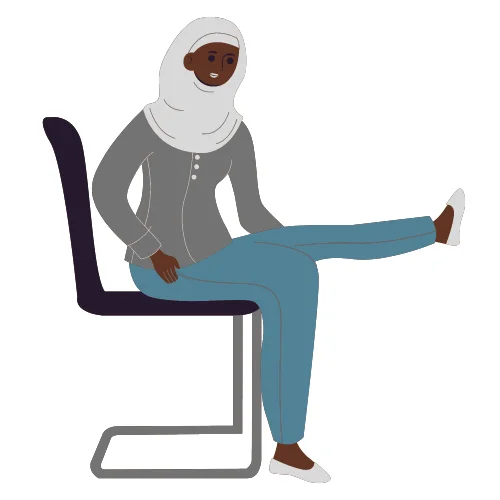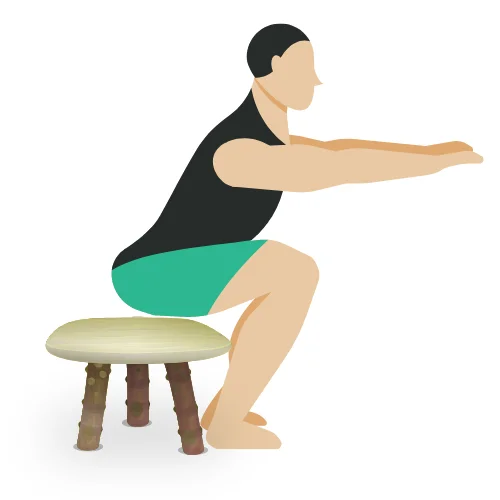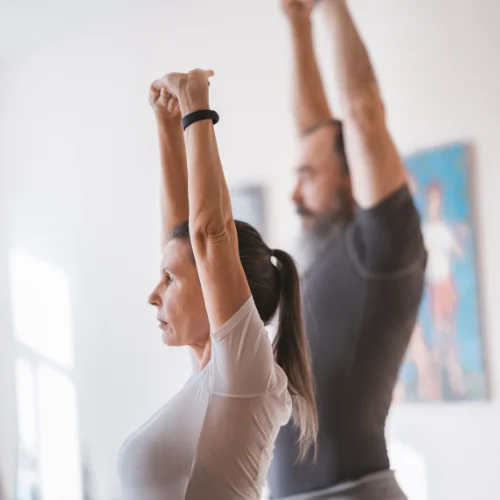10 Chair Exercises for Seniors: Stay Active and Mobile
Maintaining an active lifestyle is crucial for seniors to enhance their overall well-being and independence. Regular exercise offers numerous benefits, including improved strength, flexibility, balance, and cardiovascular health. For seniors who may have mobility limitations, chair exercises provide a safe and effective way to stay active. In this article, I will share with you 10 chair exercises specifically designed for seniors.
Here Are the 10 Best Chair Exercises for Seniors
1. Seated Leg Lifts

One of the most beneficial exercises for seniors is seated leg lifts. While seated on a sturdy chair, lift one leg straight out in front of you, hold it for a few seconds, and then lower it back down. Repeat this exercise for ten repetitions on each leg. Seated leg lifts help strengthen the leg muscles, increase flexibility, and improve blood circulation.
2. Chair Squats

Chair squats are excellent for improving lower body strength and stability. Begin by standing in front of a chair with your feet shoulder-width apart. Slowly lower yourself into a seated position, keeping your weight in your heels. Pause briefly, and then rise back up to a standing position. Aim for ten to fifteen repetitions. Chair squats engage the quadriceps, hamstrings, and glutes, promoting better balance and mobility.
3. Arm Circles

To strengthen the upper body and improve shoulder mobility, arm circles are a simple yet effective exercise. Sit upright in your chair with your feet flat on the floor. Extend your arms out to the sides, and make small circles with your hands. Gradually increase the size of the circles as you feel more comfortable. Perform ten circles forward and then ten circles backward. Arm circles help maintain shoulder flexibility and can alleviate stiffness.
4. Seated Marching
Seated marching is a great exercise to elevate the heart rate, enhance blood flow, and strengthen the leg muscles. Sit tall in your chair and lift one knee towards your chest, then lower it down. Alternate legs and maintain a steady rhythm, gradually increasing the pace. Aim for twenty to thirty marching repetitions on each leg. Seated marching improves cardiovascular fitness and boosts lower body strength.
5. Chair Yoga

Chair yoga is an excellent low-impact exercise that combines gentle stretches, breathing techniques, and meditation. It helps seniors improve flexibility, balance, and mindfulness. Numerous chair yoga poses can be practiced, such as the seated spinal twist, seated forward bend, and seated cat-cow stretch. Follow a chair yoga routine under the guidance of a qualified instructor or use online resources specifically designed for seniors.
6. Seated Row
The seated row exercise targets the back muscles, enhancing posture and strengthening the upper body. Sit in an upright position and place your feet firmly on the floor. Hold onto a resistance band or use light dumbbells. Pull your elbows back, squeezing your shoulder blades together. Slowly release back to the starting position. Aim for ten to twelve repetitions. The seated row is beneficial for maintaining a strong back and reducing the risk of back pain.
7. Toe Taps
Toe taps are a simple and effective exercise to strengthen the core muscles and improve balance. Sit with your feet flat on the floor and tap one foot lightly in front of you, then return it to the starting position. Alternate legs and gradually increase the speed as you become more comfortable. Perform twenty to thirty taps on each leg. Toe taps engage the abdominal muscles and contribute to better stability.
8. Seated Chest Press
The seated chest press is a seated version of the traditional chest press exercise. Sit tall in your chair with a resistance band or light dumbbells in each hand. Start with your elbows bent and in line with your shoulders. Push forward until your arms are fully extended, and then slowly bring them back to the starting position. Aim for ten to twelve repetitions. The seated chest press strengthens the chest, shoulders, and triceps, promoting better upper body strength and stability.
9. Seated Bicycle Crunches
Seated bicycle crunches are an effective exercise for strengthening the abdominal muscles and improving core stability. Sit on the edge of your chair with your feet lifted slightly off the floor. Place your hands lightly behind your head and engage your core. Bring your right elbow towards your left knee while extending your right leg out straight. Repeat on the other side, alternating for ten to fifteen repetitions. Seated bicycle crunches engage the rectus abdominis and obliques, enhancing core strength and balance.
10. Seated Shoulder Press
The seated shoulder press targets the deltoid muscles, promoting stronger and more stable shoulders. Sit upright in your chair with a resistance band or light dumbbells in each hand. Begin with your elbows bent and in line with your shoulders. Press the weights up overhead until your arms are fully extended, and then slowly lower them back down. Aim for ten to twelve repetitions. Seated shoulder presses enhance upper body strength and shoulder mobility.
Can chair exercises effectively improve cardiovascular health for seniors?
Chair exercises, as the name suggests, are physical activities that can be performed while seated. They are designed to target various muscle groups and elevate heart rate, thus offering a cardiovascular workout without the need for excessive mobility or high-impact movements. By utilizing a chair as a support, seniors can engage in exercises that are safe, accessible, and still yield remarkable health benefits.
One of the key advantages of chair exercises is their ability to improve cardiovascular endurance. Engaging in activities that increase heart rate, such as arm circles, seated marching, or chair dancing, stimulates blood flow and enhances the efficiency of the cardiovascular system. This can lead to improvements in oxygen delivery throughout the body and increased stamina over time.
Additionally, chair exercises can help seniors manage and control risk factors associated with cardiovascular disease. Regular physical activity has been shown to lower blood pressure, reduce cholesterol levels, and improve blood sugar regulation.
By incorporating chair exercises into their daily routine, seniors can proactively address these risk factors and potentially reduce the likelihood of developing heart-related conditions.
Furthermore, chair exercises offer a range of benefits beyond cardiovascular health. They can enhance flexibility, strengthen muscles, improve balance, and boost overall mood and mental well-being. For seniors, these advantages contribute to maintaining independence, preventing falls, and promoting a higher quality of life.
When embarking on a chair exercise program, it is crucial to consult with a healthcare professional or certified fitness instructor who specializes in senior fitness. They can guide on selecting appropriate exercises, ensuring correct form, and tailoring the program to individual needs and abilities.
Are there any specific chair exercises that target lower back pain in seniors?
Lower back pain is a common ailment among seniors, often caused by factors such as age-related degeneration, muscle imbalances, or sedentary lifestyles. While seeking professional advice is essential for addressing the root causes of back pain, incorporating specific chair exercises into a daily routine can help alleviate discomfort and strengthen the muscles supporting the lower back.
One effective exercise is the seated pelvic tilt. Start by sitting upright in a chair with your feet flat on the floor. Place your hands on your hips and gently tilt your pelvis forward, creating a slight arch in your lower back. Hold this position for a few seconds, then release and repeat. This exercise helps activate and strengthen the muscles of the lower back, promoting stability and reducing pain.
Another beneficial exercise is the seated twist. Begin by sitting tall in a chair, with your feet firmly planted on the ground. Place your right hand on the outside of your left thigh and gently rotate your torso to the left, using your hand as leverage. Keep your spine straight and your shoulders relaxed. Hold this position for a few seconds, then return to the center and repeat on the opposite side. The seated twist stretches and mobilizes the muscles along the spine, providing relief to the lower back region.
To target the core muscles and promote lower back stability, seniors can engage in chair leg lifts. Start by sitting on the edge of a chair, with your back straight and your hands gripping the sides of the seat. Extend your right leg out in front of you, keeping it straight and parallel to the floor. Hold this position for a few seconds, then lower your leg back down and repeat on the other side. Chair leg lifts engage the abdominal muscles and hip flexors, which play a crucial role in supporting the lower back.
Lastly, seniors can try seated cat-cow stretches to relieve tension in the lower back. Begin by sitting tall in a chair, placing your hands on your thighs. Inhale deeply and arch your back, pushing your chest forward and lifting your gaze upward (the “cow” position). Exhale slowly, rounding your back and tucking your chin towards your chest (the “cat” position). Repeat this sequence several times, focusing on the fluid movement of the spine. Seated cat-cow stretches promote flexibility and release tension in the lower back area.
It’s important to remember that each individual is unique, and it’s advisable to consult with a healthcare professional or a qualified fitness instructor before starting any exercise program, especially if you have pre-existing back conditions or injuries. They can provide personalized guidance and ensure that the exercises are performed correctly and safely.
What are the recommended repetitions and sets?
For beginners or individuals with limited mobility, starting with lower repetitions and sets is recommended. A good starting point is performing 8 to 10 repetitions (reps) of each exercise, gradually building up to 2 or 3 sets. This allows the body to adjust and adapt to the movements without overwhelming the muscles and joints.
As seniors progress and become more comfortable with the exercises, increasing the number of repetitions and sets can provide additional challenges and promote further strength gains. Intermediate individuals can aim for 10 to 15 reps per exercise, with 2 or 3 sets. This higher repetition range helps improve endurance and muscle stamina.
For more advanced seniors or those seeking to increase the intensity of their workouts, going beyond 15 reps per exercise can be beneficial. Pushing the limits by performing 15 to 20 reps, or even higher, challenges the muscles and cardiovascular system, promoting further development and functional improvements. However, it’s important to maintain proper form and listen to the body’s signals to prevent overexertion or injury.
Can chair exercises help seniors improve their posture and reduce muscle imbalances?
One of the key benefits of chair exercises is their ability to strengthen the muscles that support proper posture. By targeting specific muscle groups, such as the core, back, and shoulders, seniors can develop the strength and stability necessary to maintain an upright posture. Exercises like seated rows, shoulder retractions, and seated spinal twists engage these muscles, helping to counteract the effects of prolonged sitting and poor posture habits.
In addition to strengthening the muscles, chair exercises also improve flexibility and mobility, which are essential for maintaining good posture. Stretching exercises like seated forward bends and chest stretches help lengthen tight muscles, such as the hamstrings and chest muscles, which can contribute to poor posture. By incorporating these exercises into their routine, seniors can alleviate muscle imbalances and promote a more balanced and upright posture.
Moreover, chair exercises focus on the core muscles, which play a crucial role in maintaining proper posture. The core acts as a stabilizer for the spine and pelvis, and a strong core can significantly improve posture. Seated exercises like seated knee lifts, seated Russian twists, and seated leg extensions engage the core muscles, helping to support the spine and prevent slouching.
Consistency is key when it comes to improving posture through chair exercises. Seniors should aim to incorporate these exercises into their daily routine and perform them with proper form and alignment. Gradually increasing the intensity and duration of the exercises can further enhance their effectiveness.
It’s worth noting that while chair exercises can be beneficial for improving posture and reducing muscle imbalances, it’s important to seek guidance from a healthcare professional or a certified fitness instructor. They can provide individualized recommendations and ensure that exercises are performed safely and effectively.
Are there any potential risks or precautions to consider?
One key consideration is proper form and technique. It’s essential to perform exercises with correct posture and alignment to avoid strain or injury. Seniors should pay attention to their body positioning, ensuring that the spine is neutral, shoulders are relaxed, and movements are smooth and controlled. Engaging the appropriate muscles and avoiding excessive strain or jerky movements is crucial for injury prevention.
Another precaution is to start with a proper warm-up. Before beginning chair exercises, seniors should perform a brief warm-up routine to increase blood flow to the muscles and prepare the body for physical activity. This can include gentle stretching, joint mobility exercises, or light cardiovascular movements such as marching in place. A warm-up helps to reduce the risk of muscle strains or joint injuries.
Individuals with certain health conditions or mobility limitations should consult with a healthcare professional or a certified fitness instructor before starting a chair exercise program. They can provide guidance on exercises that are safe and appropriate for specific conditions or limitations. It’s important to disclose any relevant health information and follow their recommendations to ensure a tailored and safe exercise routine.
Seniors should also listen to their bodies and avoid pushing beyond their limits. Overexertion or excessive fatigue can increase the risk of injury. It’s important to progress gradually, starting with exercises that match individual fitness levels and gradually increasing intensity or duration over time. Rest and recovery periods should be incorporated into the exercise routine to allow the body to heal and adapt.
Lastly, the choice of a stable and sturdy chair is vital. Seniors should ensure that the chair they use for exercises is in good condition and can support their weight and movements. A chair with armrests and a solid backrest can provide additional stability and support during exercises.
Conclusion
Regular physical activity is essential for seniors to maintain their independence and overall well-being. Chair exercises provide a safe and convenient way for older adults to stay active, even with mobility limitations. The 10 exercises mentioned in this article offer a comprehensive workout targeting various muscle groups and promoting cardiovascular health, flexibility, strength, and balance.
Remember, it’s crucial to consult with a healthcare professional before starting any new exercise routine, especially if you have any underlying health conditions or concerns. Start slowly and gradually increase the intensity and duration of your workouts as you feel comfortable.
Now it’s your turn. What are some of your favorite chair exercises for seniors? Have you tried any of the exercises mentioned in this article?
Share your thoughts, experiences, and suggestions in the comments section below. Let’s engage in a conversation and support each other on the journey to a healthier and more active lifestyle.
